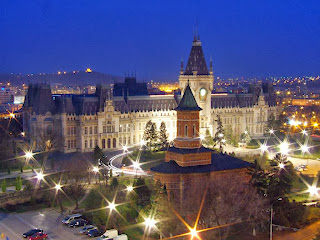Metropolitanate of Moldavia and Bukovina Iasi
 Cathedral Building took place at the initiative of Veniamin Costache and founding act was the Royal Charter of 08.08.1926. The works were held for 6 years 1833-1839 after which were cut off because of falling boltii. The building remains a ruin for 40 years. In 1880 the works shall be started in 1887 is completed.
Cathedral Building took place at the initiative of Veniamin Costache and founding act was the Royal Charter of 08.08.1926. The works were held for 6 years 1833-1839 after which were cut off because of falling boltii. The building remains a ruin for 40 years. In 1880 the works shall be started in 1887 is completed.Iasi Metropolitan Cathedral stands the world's influential architectural style Italian Baroque style. In 1889 were brought to Saint James relics Metropolitanate Segments, patron.
Today the Orthodox Church represents a true pole of Moldavian religious, an important place of pilgrimage. On the 14th of October each year the relics of Saint Paraskeva Segments through a religious ritual are removed out of the Metropolis during which thousands of peleniri from all over the country come to celebrate this event, to worship.
Three Hierarchs monastery Iasi
Built in 1635 by engraving in stone. On the South façade one can read the inscription that was built in the name of the three Saints: Basil the great, Gregory the theologian and John Chrysostom as the founder's Auravand one of the most important figures of the time: the ruler of Moldova: Vasile Lupu.
three Holy hierarchs iasi In sign of gratitude for Prince Vasile Lupu, were sent by the Patriarchate of Constantinople the relics of Saint Parascheva in 1641. Later in 1887 they were displaced in the Metropolitan Cathedral, Iaşi.
The building is the famous stone embroidery on the exterior walls that has been preserved in original form in mostly inspired by Asian and Western elements. Patron Saint is celebrated on January 30
Golia Monastery, Iasi

Old church built by logofatul Ioan Golia in the 16th century was rebuilt at other sizes according to the writings of Miron Costin in the years 1634-1653 by Vasile Lupu sii finished in 1660 by his son Stefanita.
So far, Golia Monastery has been rebuilt countless times after fires in 1687, 1733, 1822 and affected by an earthquake in 1738. The wall surrounding the monastery of 9 m tall and 1 m thick was erected in 1667.
Goliei Tower is considered one of the symbols of Iasi is 30 m high and is a famous tourist attraction for those who want to admire the city of Iasi from height. Inside the wall that surrounds the Golia Monastery we find House-Museum in the Ion Creanga between years 1866-1871.










